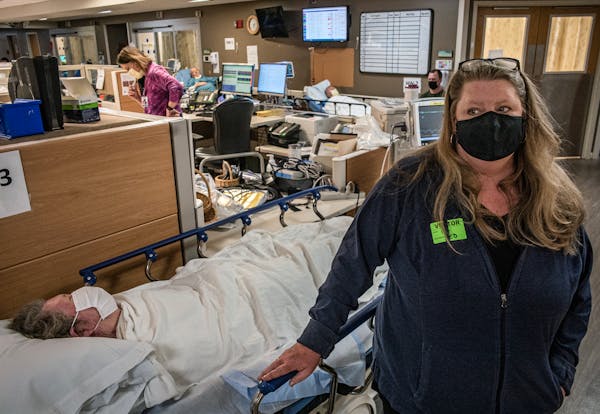Leading Minnesota pediatricians on Monday urged parents to consider alternatives to emergency room visits for mildly ill children during an early and busy flu season that is clogging hospital beds.
While severely ill children need immediate care — particularly those who are dehydrated or struggling to breathe — doctors said there are many patients coming in who could be cared for at home.
"Fevers in and of themselves are not a reason to come into the emergency room unless they're persisting for a long time," said Dr. Andrea Singh, chair of pediatrics at Park Nicollet. "More than four to five days, we probably do want to see you."
Doctors from six competing medical systems held a joint news conference Monday to offer a unified voice of caution to Minnesotans amid early and high levels of infections involving RSV and influenza — and still some COVID-19.
Only two of 144 pediatric intensive care beds were available in Minnesota on Nov. 15, a 98% occupancy rate that only occurred twice at the peaks of the COVID-19 pandemic, according to the most recent state update. Only 29 of 441 general pediatric beds were available on that date. The high occupancy rates are forcing more children in need of inpatient care to sit in emergency rooms, and more patients in need of ER care to sit in waiting rooms.
"There have been days when we have had 30 to 40 children waiting in our emergency department for an inpatient bed," said Dr. Rob Sicoli, medical director for Children's Minnesota's ERs in Minneapolis and St. Paul. "That's unprecedented. That backs up the care for all of the other children."
RSV, short for respiratory syncytial virus, is common among infants each winter, but usually not until December. Conditions have changed amid the COVID-19 pandemic, though, because RSV emerged in the summer last year and in the fall this year. More than 180 RSV-related hospitalizations were reported among patients in the seven-county Twin Cities metro area in the week ending Nov. 12, according to the state's weekly reporting on respiratory diseases.
The 439 flu-related hospitalizations in Minnesota also are unusually high at this point in the late fall, according to the state report. The median age of those hospitalized patients is only 48, below the norm of 50 to 70 and reflecting the rise in infections among children. No pediatric flu-related deaths have been reported so far.
The doctors walked a fine line in their messaging Monday, not wanting to discourage parents from bringing in children needing hospital-level care.
Parents should probably consult with their local pediatricians first, said Dr. Ashley Strobel, an emergency physician at Hennepin Healthcare in Minneapolis, which hosted the news conference.
But she said parents should bring in children who are dehydrated (often exhibited by dry diapers), have fevers above 100.4 degrees for five or more days or are struggling to breathe so much that their ribs can be seen as they inhale or "their nostrils are flaring out and in, kind of like that bull that you see on cartoons, back in the day of Looney Tunes."
Seeking RSV testing in mild cases isn't necessary — there are no specific treatments for the infection in most cases — and takes up limited capacity in clinics and hospitals, said Dr. Jill Amsberry, medical director of the pediatrics and adolescent clinic of St. Cloud-based CentraCare.
"We do not need to do RSV testing to go back to day care or to school. If you don't have other needs in the health care settings, we just urge you to stay home," Amsberry said.
Staffing shortages at hospitals — partly because of an exodus of workers amid the COVID-19 pandemic — have contributed to the pressures, along with rising patient numbers.
Sicoli said the current situation with flu and RSV is akin to a "bad middle of the winter" in other years. However, it's unclear if the early start to the respiratory virus season will result in an extended season or just an early peak followed by a milder winter.
Fears of a severe flu season originated globally in Australia, which had an early spike in sick children, but it dissipated quickly and did not take an unusually harsh toll on the elderly. Other portions of the Southern Hemisphere didn't have severe flu seasons.
RSV-related hospitalizations may have already plateaued in Minnesota, but are still creating pressure along with the sudden rise in influenza cases. Besides deciding whether to take children in for care, parents can help by reducing illnesses in the first place, said Dr. Will Nicholson, president of the Minnesota Medical Association and vice president of medical affairs for M Health Fairview's east metro hospitals.
Strategies include staying home when sick, washing hands, getting vaccinated and wearing masks in crowded, high-risk locations, he said.
"We need your help. We need you guys to join our team," Nicholson said. "Right now, there's a lot you can do to stay healthy. We want you to stay healthy."
Carolyn Parnell, 'trailblazer' who served as Minnesota's first IT commissioner, dies

